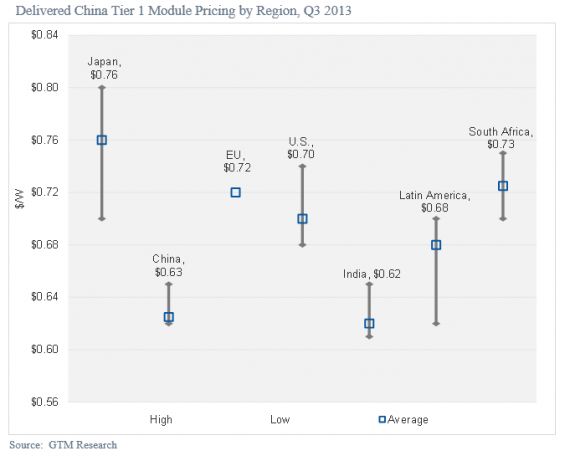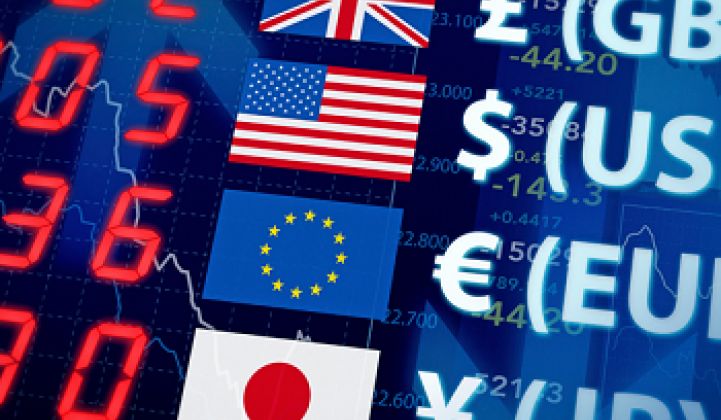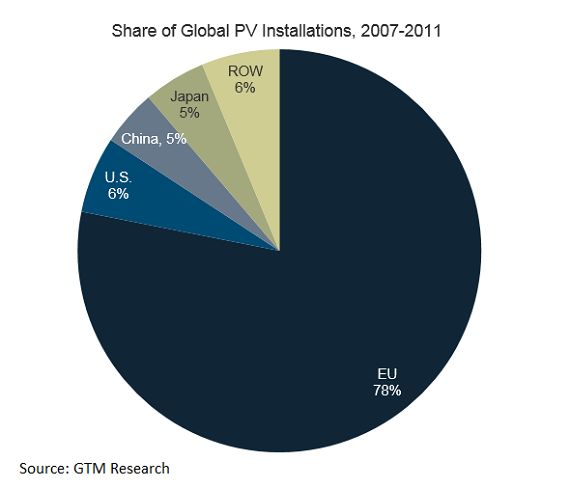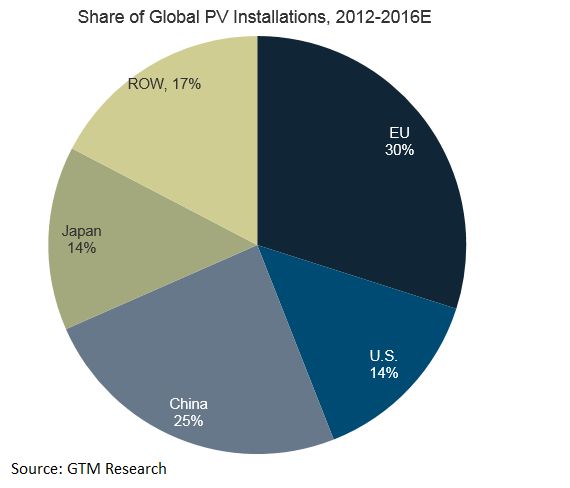Prior to 2013, it was acceptable to quote a single crystalline silicon module price (specific to a particular producer profile) to represent the entire globe. This is not the case in today’s PV market. Suppliers are looking at a more intricate pricing landscape, and there are two noteworthy reasons why.
2007-2011 vs. 2012-2016: Demand Diffusion Takes Hold
First, demand isn’t as concentrated as it was before. The graphs below illustrate two distinct eras of demand within a ten-year period: one where PV installations were highly concentrated in one relatively interconnected region (the EU) and one where regional installation diversity has truly emerged. From 2007 to 2011, Europe essentially was the global PV market, making up 78% of cumulative global PV installations. In this scenario, it was fair game to quote Chinese c-Si module pricing in Germany to represent Chinese c-Si pricing throughout the world at large, given that 1) Germany represented over 50% of the European market; 2) Europe represented 78% of the global market; and 3) module pricing variation in Europe was minimal.
Looking forward, things are very different. Due to multiple changes in incentives and policy structures, the period from 2012 to 2016 is expected to show much greater regional diversity.
Over this time, we estimate that installations in the EU will only represent 30% of installed PV capacity, with Japan, China and the U.S. emerging as notable markets (defined as regions that represent 10% or more of total installations). With significantly greater geographic diversity in end-demand, it becomes difficult to justify using pricing from any one market as a proxy for the entire world.
Regional Pricing Drivers
An increasingly diverse end-market brings us to point number two on why suppliers are looking at a different pricing landscape today. It isn’t just that there is a greater number of notable end-markets; in contrast to the mostly feed-in tariff-incentivized past, the end-markets of today and tomorrow are characterized by unique price drivers that have driven regional price variations to noteworthy levels. GTM classifies regional module pricing drivers into the following three broad categories:
- Geopolitical Factors: This is an umbrella term for regional constraints such as import duties, price settlements and/or domestic content restrictions and requirements, and it is a major driver for current regional pricing differences. The negotiated price settlement for Chinese module imports into the EU, currently set at around $0.76/W, is the clearest example of this, as is the requirement for domestically produced cells and modules in India’s National Solar Mission. Similarly, U.S. import duties on Chinese produced cells push Chinese module manufacturers to procure Taiwanese cells, which currently cost 5 to 8 cents per watt more than in-house Chinese cells, and this increased cost is currently passed on to the customer.
- Regional Power Pricing/Incentive Levels: Different levels of PV incentives support a range of system economics which result in regional variation in component pricing. In general, lower power pricing in India and China has influenced lower solar PPA pricing and in turn has lowered system and module pricing requirements; on the flip side, Japan’s generous FIT supports significantly higher module pricing than the global average.
- Downstream Customer Preference: Dependent on brand, bankability and supplier product preference, downstream preference can push module prices to either extreme. Take for example Japan’s residential market segment, which has the highest module prices in the world -- a distinction it owes to its preference for local brands and more expensive mono c-Si technology. Similarly, stringent bankability screening criteria in the U.S. market have made it difficult for lower-priced Tier 2 and Tier 3 Chinese suppliers to gain much traction.
Current Regional Module Prices
The graph below (pulled from our latest report, Global PV Price Outlook 2014: Value Chain Trends, Global Drivers and Regional Dynamics) illustrates the high level of geographic pricing spreads the industry sees today. As shown, current delivered module pricing for Tier 1 Chinese modules ranges from $0.56/W for utility-scale projects in Latin America on the low side, to $0.80/W in Japan -- a mean spread of 35%. Below, we briefly examine current module pricing trends in the major PV end-markets.

U.S.: Q4 2013 delivered pricing for Chinese modules in the U.S. ranges from $0.67-$0.74/W depending on the individual supplier and order volume. There is a natural pecking order, with Hanwha Solar at the high end and less established firms such as Lightway and Talesun at the lower end of the range. Generally, our estimates are representative of order volumes less than 3 MW. We estimate pricing for larger order volumes (>5 MW) to be around 3% lower based on sales quotes we have viewed.
EU: The negotiated price floor for Chinese module imports into the EU is currently set at €0.56/W CIF, or $0.76/W assuming an FX rate of 1.35. Since Chinese suppliers can no longer compete with each other on price, they are attempting to differentiate on efficiency/power rating metrics; reports indicate that hardly any modules below the 250-watt mark are still being put on the European market by leading Chinese firms. Due to the price floor, Chinese modules are no longer the least expensive option in the EU. Modules from India, Malaysia and Taiwan priced around $0.69/W have been imported in meaningfully higher quantities since Q3.
Japan: Delivered pricing for Tier 1 Chinese modules in the Japanese commercial market was around $0.80/W in early Q4. Pricing in the utility-scale segment, which is dominated by Chinese players, is currently around $0.70/W. Multiple sources have noted that competition in the commercial and utility space has been intensifying in Q3, and that prices have been dropping in contrast to the global trend.
China: Module pricing in the Chinese market in early Q4 was $0.62-$0.64/W. Selling prices in the Chinese market were in the high-$0.50/W at the beginning of the year, but increased by more than 10% in Q1-Q3. This is partly a function of inventory clearing at the beginning of the year, as well as a rush to complete projects in Q2 and Q3 in order to receive the higher feed-in tariff. Numerous suppliers have noted that pricing in China was still increasing in Q3, and that ASPs in China would be on par with the global average by year-end.
Latin America: Delivered Tier 1 Chinese module pricing in Mexico and Brazil (both primarily rooftop markets) in Q4 2013 is around $0.68-$0.70/W. This is meaningfully higher than pricing in Chile, where pricing ranges from $0.56-$0.64/W for 20 MW-plus projects due to the focus on utility-scale deployment and demanding power price requirements set by mining companies (the primary offtakers of solar electricity in Chile). Many module suppliers have been selling inventory from 2012, including lower-wattage modules that are out of production (e.g. 235W 60-cell modules, 280W 72-cell modules) -- into the Latin American markets at low prices (mid-$0.50/W). Some of this low-cost “stranded” inventory from the U.S. is still being cleared in Latin America -- we have heard pricing of $0.50/W for Sharp modules (including warranty) in Q4, for example.
For a deeper dive on our scenario-based near-term and long-term forecast for polysilicon, wafer, cell and module pricing, check out GTM Research's new report, Global PV Price Outlook 2014: Value Chain Trends, Global Drivers and Regional Dynamics.





